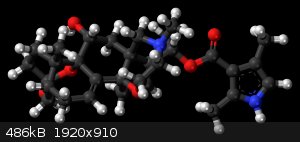dimikizi
Harmless

Posts: 1
Registered: 22-12-2014
Member Is Offline
Mood: No Mood
|
|
Thioacetone
Hello,
I'm interested in buying/making thioacetone (the chemical that smells really bad)
Can anyone help me ?
Regards.
|
|
|
j_sum1
Administrator
       
Posts: 6333
Registered: 4-10-2014
Location: At home
Member Is Offline
Mood: Most of the ducks are in a row
|
|
Thread on subject less than two weeks old.
https://www.sciencemadness.org/whisper/viewthread.php?tid=55...
It is forum protocol here to search first and add to an existing thread rather than start a new one. If you ask, a mod might oblige in merging for
you.
|
|
|
bismuthate
National Hazard
   
Posts: 803
Registered: 28-9-2013
Location: the island of stability
Member Is Offline
Mood: self reacting
|
|
Don't.
Seriously, just don't.
|
|
|
Mailinmypocket
International Hazard
    
Posts: 1351
Registered: 12-5-2011
Member Is Offline
Mood: No Mood
|
|
Sheesh. Lately If it isn't somebody new asking for a "recipe" to make sodium cyanide it's this
[Edited on 23-12-2014 by Mailinmypocket]
|
|
|
HgDinis25
Hazard to Others
  
Posts: 439
Registered: 14-3-2014
Location: Portugal
Member Is Offline
Mood: Who drank my mercury?
|
|
Quote: Originally posted by Mailinmypocket  | Sheesh. Lately If it isn't somebody new asking for a "recipe" to make sodium cyanide it's this
[Edited on 23-12-2014 by Mailinmypocket] |
Oh the humanity!
|
|
|
gdflp
Super Moderator
      
Posts: 1320
Registered: 14-2-2014
Location: NY, USA
Member Is Offline
Mood: Staring at code
|
|
Yeah what's next, fluorine because it looks neat?
|
|
|
Molecular Manipulations
Hazard to Others
  
Posts: 447
Registered: 17-12-2014
Location: The Garden of Eden
Member Is Offline
Mood: High on forbidden fruit
|
|
How about Batrachotoxin because it's structure is kewl

|
|
|
subsecret
Hazard to Others
  
Posts: 424
Registered: 8-6-2013
Location: NW SC, USA
Member Is Offline
Mood: Human Sadness - Julian Casablancas & the Voidz
|
|
First, you will isolate some impure thioacetone oil, and the stench will be bearable. When you recrystallize it and leave it to dry, the intensity of
the smell will increase, and you will probably vomit. Your dog will cough up the squirrel he had for lunch, and the area near your house will be
cleared of songbirds. When you stumble outside to get some fresh air, the wind will catch the air in your laboratory, and distribute a portion of the
material to each of your neighbors. Merry Christmas. Thank goodness that they haven't eaten dinner, but that doesn't matter, because they probably
won't be eating at home anyway after that. Your angry neighbors will go to torches and pitchforks, or more likely, the police, and then you'll have to
explain to them why you made such a smelly material.
It's probably a bad idea.
Fear is what you get when caution wasn't enough.
|
|
|
careysub
International Hazard
    
Posts: 1339
Registered: 4-8-2014
Location: Coastal Sage Scrub Biome
Member Is Offline
Mood: Lowest quantum state
|
|
Funny thing about this - the "thioacetone" (or whatever the exact odorant is) is perfectly harmless - unlike toxic chemicals, and explosives no
physical harm can come to you - yet this looks like one of them most hazardous areas of experimentation for a home lab.
Compare say to an extremely toxic compound, say, a nerve agent.
The nerve agent will have its physical, chemical and toxic properties thoroughly documented, and the synthesis will be very well known (a lot of
literature on this). Thus it is possible to design experiments such that very small amounts are produced and manipulated safely and the methods of
dealing with any very small accidental releases straightforward and efficient. Though quite toxic per unit mass, that toxicity is well measured and
bounded and can be managed.
None of this is true with "thioacetone".
If the exact identity of the odorant is indeed in doubt (check the other Thioacetone thread) then obviously its properties are not well understood.
Little seems to be available about the reactions that produce it, since no one wants to make it. It seems to be harmful in extremely small amounts,
with little indication of how low it might go. Decontamination seems difficult. There seem to be no grounds to design a sensible preparation even on
the micro scale with predictable and controlled effects.
If you were running a macro (or maybe even a micro) scale reaction and stumbled upon really efficient reaction conditions for production of the
odorant then heaven help you.
This is the sort of bad episode that could potentially get a house condemned and torn down if odor decontamination cannot be accomplished.
Consider the case of the USS Bistera, a destroyer escort that was contaminated by a few hundred grams of mustard gas after picking up men contaminated
by a CW munition store explosion at Bari Harbor in WWII. Large amounts of decontaminating agents were used to try to remove the residual contamination
left from the men's clothing, but were unsuccessful and the ship was scuttled.*
One could imagine a persistent extreme noxious odorant absorbed on the surfaces of a dwelling being impossible to remove.
*I should clarify - a few hundred grams was the total amount of bis(2-chloroethyl) sulfide brought aboard, mostly as clothing contaminant. After the
clothing was removed and destroyed, and the areas where the men were housed washed down by decontaminating solution, the total residual contamination
of the vessel from migrating vapor was no more than several grams. This is what they could not get rid of, and led to scuttling the ship.
[Edited on 25-12-2014 by careysub]
|
|
|
macckone
Dispenser of practical lab wisdom
    
Posts: 2168
Registered: 1-3-2013
Location: Over a mile high
Member Is Offline
Mood: Electrical
|
|
This sounds like a good experiment to perform in the middle of the ocean before ditching the vessel you are on.
|
|
|